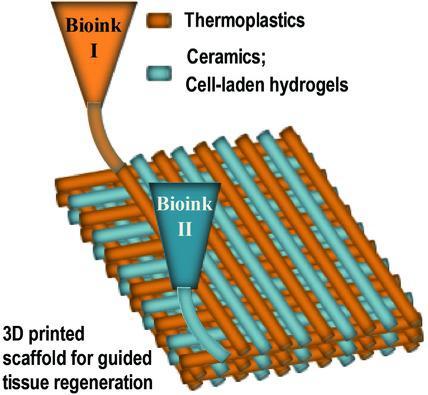当前位置:
X-MOL 学术
›
Small Methods
›
论文详情
Our official English website, www.x-mol.net, welcomes your feedback! (Note: you will need to create a separate account there.)
3D‐Printed Biomaterials for Guided Tissue Regeneration
Small Methods ( IF 12.4 ) Pub Date : 2018-01-22 , DOI: 10.1002/smtd.201700306 Ben Zhang 1 , Jie Song 1
Small Methods ( IF 12.4 ) Pub Date : 2018-01-22 , DOI: 10.1002/smtd.201700306 Ben Zhang 1 , Jie Song 1
Affiliation

|
Fabrication of 3D scaffolds with interconnected macro‐/microporosity, compositional gradient, biological cues, and precise geometric configurations matching with that of a tissue defect, along with the choice of appropriate biomaterials, is central to the success of scaffold‐guided tissue‐regeneration strategies. Customized high‐speed 3D‐printing technology enables efficient fabrication of 3D scaffolds for regenerative‐medicine applications. In addition to recent technological advances in 3D‐printing methods and instrumentation, progress has been made in the expansion of printable biomaterials and cell‐laden bioinks. Here, a brief overview of the 3D‐printing techniques most commonly used for biomedical applications is given, followed by a discussion of common bioceramics, natural biopolymers, and synthetic degradable thermoplastic polymers, as well as their cell/biofactor‐laden composites used for 3D printing. Advantages and limitations of these printing techniques and bioinks for various tissue repair/regeneration applications are highlighted.
中文翻译:

用于引导组织再生的3D打印生物材料
具有相互连接的大孔/微孔,组成梯度,生物学线索以及与组织缺损相匹配的精确几何构型的3D支架的制造以及适当生物材料的选择对于支架引导的组织再生策略的成功至关重要。定制的高速3D打印技术可为再生医学应用高效地制造3D支架。除了3D打印方法和仪器方面的最新技术进步之外,可打印生物材料和充满细胞的生物墨水的发展也取得了进展。在此,简要概述了最常用于生物医学应用的3D打印技术,然后讨论了常见的生物陶瓷,天然生物聚合物和合成可降解热塑性聚合物,以及用于3D打印的含细胞/生物因子的复合材料。这些印刷技术和生物墨水在各种组织修复/再生应用中的优点和局限性得到了强调。
更新日期:2018-01-22
中文翻译:

用于引导组织再生的3D打印生物材料
具有相互连接的大孔/微孔,组成梯度,生物学线索以及与组织缺损相匹配的精确几何构型的3D支架的制造以及适当生物材料的选择对于支架引导的组织再生策略的成功至关重要。定制的高速3D打印技术可为再生医学应用高效地制造3D支架。除了3D打印方法和仪器方面的最新技术进步之外,可打印生物材料和充满细胞的生物墨水的发展也取得了进展。在此,简要概述了最常用于生物医学应用的3D打印技术,然后讨论了常见的生物陶瓷,天然生物聚合物和合成可降解热塑性聚合物,以及用于3D打印的含细胞/生物因子的复合材料。这些印刷技术和生物墨水在各种组织修复/再生应用中的优点和局限性得到了强调。


























 京公网安备 11010802027423号
京公网安备 11010802027423号